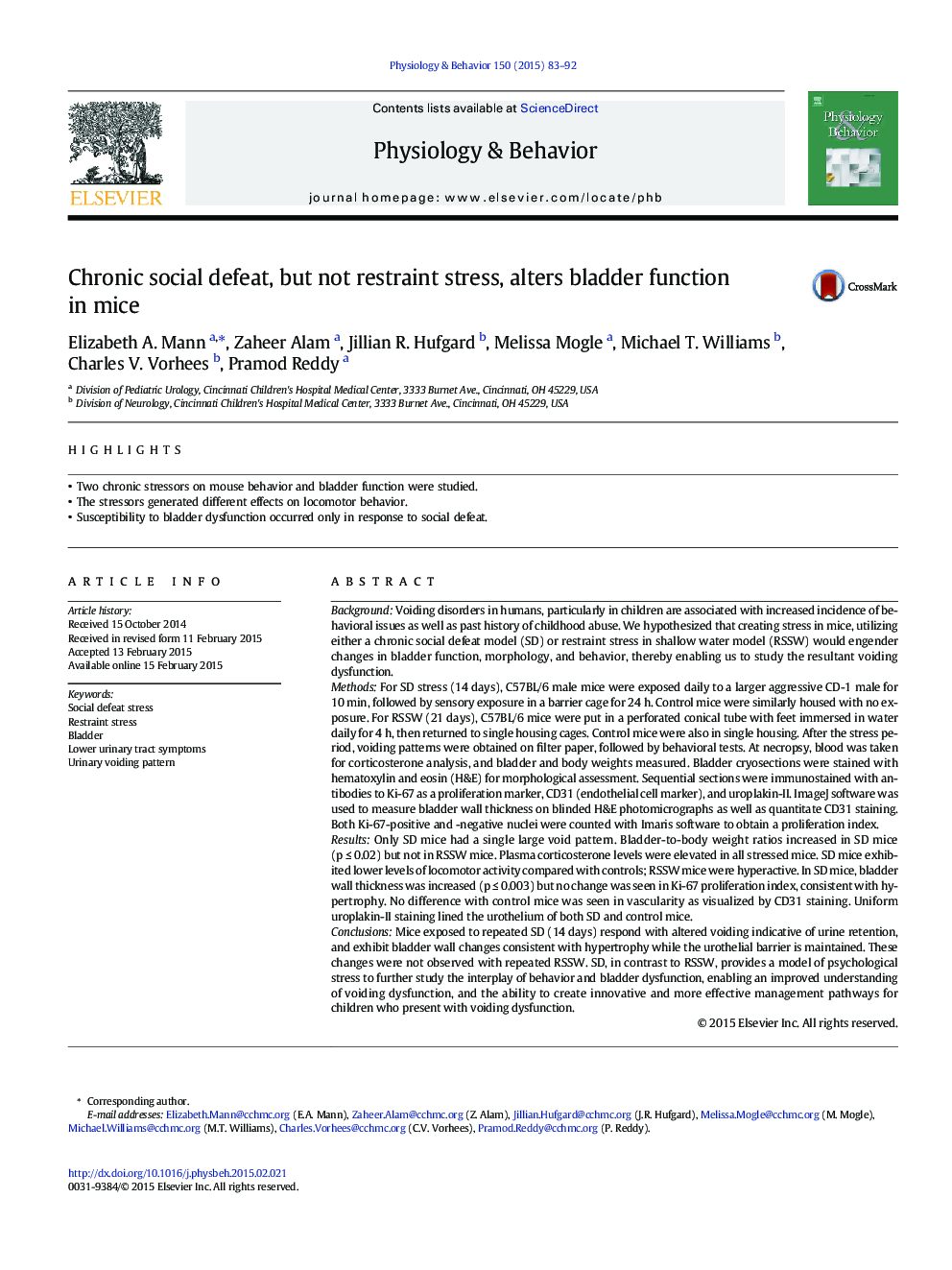| کد مقاله | کد نشریه | سال انتشار | مقاله انگلیسی | نسخه تمام متن |
|---|---|---|---|---|
| 5923414 | 1571167 | 2015 | 10 صفحه PDF | دانلود رایگان |
- Two chronic stressors on mouse behavior and bladder function were studied.
- The stressors generated different effects on locomotor behavior.
- Susceptibility to bladder dysfunction occurred only in response to social defeat.
BackgroundVoiding disorders in humans, particularly in children are associated with increased incidence of behavioral issues as well as past history of childhood abuse. We hypothesized that creating stress in mice, utilizing either a chronic social defeat model (SD) or restraint stress in shallow water model (RSSW) would engender changes in bladder function, morphology, and behavior, thereby enabling us to study the resultant voiding dysfunction.MethodsFor SD stress (14 days), C57BL/6 male mice were exposed daily to a larger aggressive CD-1 male for 10 min, followed by sensory exposure in a barrier cage for 24 h. Control mice were similarly housed with no exposure. For RSSW (21 days), C57BL/6 mice were put in a perforated conical tube with feet immersed in water daily for 4 h, then returned to single housing cages. Control mice were also in single housing. After the stress period, voiding patterns were obtained on filter paper, followed by behavioral tests. At necropsy, blood was taken for corticosterone analysis, and bladder and body weights measured. Bladder cryosections were stained with hematoxylin and eosin (H&E) for morphological assessment. Sequential sections were immunostained with antibodies to Ki-67 as a proliferation marker, CD31 (endothelial cell marker), and uroplakin-II. ImageJ software was used to measure bladder wall thickness on blinded H&E photomicrographs as well as quantitate CD31 staining. Both Ki-67-positive and -negative nuclei were counted with Imaris software to obtain a proliferation index.ResultsOnly SD mice had a single large void pattern. Bladder-to-body weight ratios increased in SD mice (p â¤Â 0.02) but not in RSSW mice. Plasma corticosterone levels were elevated in all stressed mice. SD mice exhibited lower levels of locomotor activity compared with controls; RSSW mice were hyperactive. In SD mice, bladder wall thickness was increased (p â¤Â 0.003) but no change was seen in Ki-67 proliferation index, consistent with hypertrophy. No difference with control mice was seen in vascularity as visualized by CD31 staining. Uniform uroplakin-II staining lined the urothelium of both SD and control mice.ConclusionsMice exposed to repeated SD (14 days) respond with altered voiding indicative of urine retention, and exhibit bladder wall changes consistent with hypertrophy while the urothelial barrier is maintained. These changes were not observed with repeated RSSW. SD, in contrast to RSSW, provides a model of psychological stress to further study the interplay of behavior and bladder dysfunction, enabling an improved understanding of voiding dysfunction, and the ability to create innovative and more effective management pathways for children who present with voiding dysfunction.
Journal: Physiology & Behavior - Volume 150, 15 October 2015, Pages 83-92
